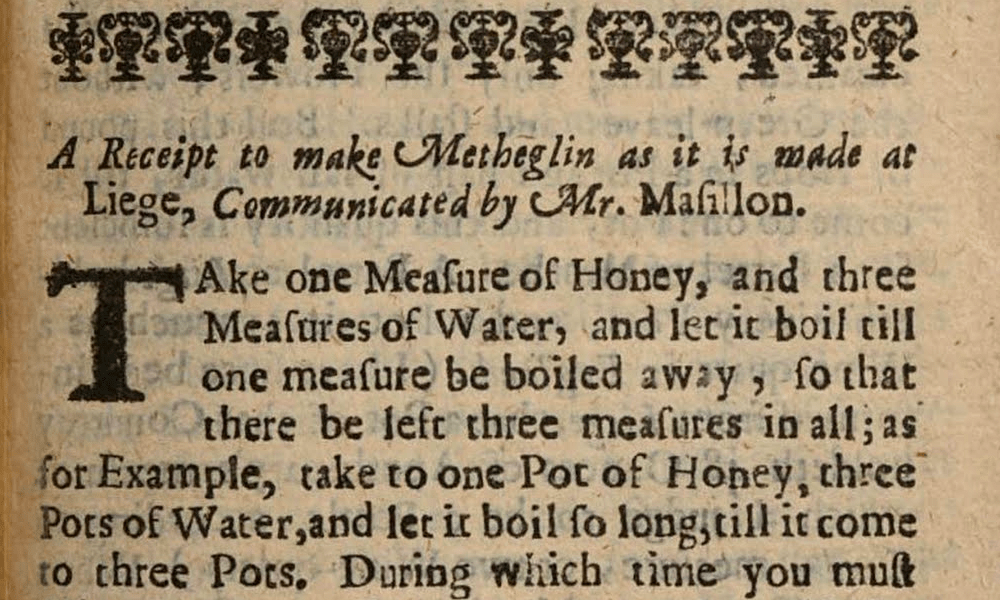
In this series we create modern interpretations of ancient meads. This time we will look at a circa 1660 metheglin recipe from Belgium. The original recipe says that hops can be used to help preserve the mead, and we will be making that miodomel (mead with hops) version. We are going to use Saaz hops, which we hope will help bridge the mildness of the mead with the spiciness of the clove and ginger. Our one gallon interpretation uses SafAle BE-256 yeast, paying homage to the original recipe’s Belgian roots. The original and modern interpretations are below, if you are up to it.
A Receipt to make Metheglin as it is made at Leige, Communicated by Mr. Maſillon.
Take one Meaſure of Honey, and three Meaſures of Water, and let it boil till one meaſure be boiled away, ſo that there be left three meaſures in all; as for Example, take to one Pot of Honey, three Pots of Water, and let it boil ſo long, till it come to three Pots. During which time you muſt Skim it very well as ſoon as any ſcum riſeth; which you are to continue till there riſe no ſcum more. You may, if you pleaſe, put to it ſome ſpice, to wit, Cloves and Ginger; the quantity of which is to be proportioned according as you will have your Meath, ſtrong, or weak. But this you do before it begin to boil. There are ſome that put either Yeaſt of Beer, or Leaven of Bread into it, to make it work. But this is not neceſſary at all; and much leſs to ſet it into the Sun. Mr. Maſillon doth neither the one nor the other. Afterwards for to Tun it, you muſt let it grow Lukewarm, for to advance it. And if you do intend to keep your Meath a long time, you may put into it ſome hopps on this faſhion. Take to every Barrel of Meathe a Pound of Hops without leaves, that is, of Ordinary Hops uſed for Beer, but well cleansed, taking only the flowers, without the Green-leaves and ſtalks. Boil this pound of hops in a Pot and half of fair water, till come to one Pot, and this quantity is ſufficient for a Barrel of Meathe. A Barrel at Liege holdeth ninety Pots, and a Pot is as much as a Wine quart in England. (I have ſince been informed from Liege, that a Pot of that Countrey holdeth 48 Ounces of Apothecary’s meaſure: which I judge to be a Pottle according to London meaſure, or two Wine quarts.) When you Tun your Meath, you muſt not fill your Barrel by half a foot, that ſo it may have room to work. Then let it ſtand ſix weeks ſlightly ſtopped; which being expired, if the Meath do not work, ſtop it up very cloſe. Yet muſt you not fill up the Barrel to the very brim. After ſix Months you draw off the clear into another Barrel, or ſtrong Bottles leaving the dregs, and filling up your new Barrel, or Bottels, and ſtopping it or them very cloſe.
The Meath that is made this way, (Viz. In the Spring, in the Month of April or May, which is the proper time for making of it,) will keep many a year.
Ingredients:
Directions:
For a one gallon batch, set 32 fluid ounces of water aside to chill. Then, in a 2 quart or larger pot, bring 48 fluid ounces of water to a boil. Add hops and spices according to the following schedule:
Be sure to watch the boil so that it does not boil over, and stir often to prevent burning of the hops. The staggered schedule has the following purposes:
After the boil is complete, pour the hops and water through a strainer into another sanitized 2 quart or larger pot. Let the liquid chill until it is below about 120 degrees. Pour 3 pounds of honey into the same pot and stir with a sanitized spoon. Pour chilled water into a sanitized gallon jug. Using a sanitized funnel, pour hopped honey water (the must) into the gallon jug. Be sure to leave head-space in the jug. Once the temperature is below 80℉, mix one half of the BE-256 yeast with water and then pitch directly into the gallon jug. Place an airlock on the jug and set in a cool (60-68℉) dark place.
After fermentation is complete, in 2-3 weeks, rack to another sanitized gallon jug. Racking immediately after fermentation is complete is important for this strain of yeats. Let it bulk age until clear. Add one Campden tablet (potassium metabisulfite) prior to bottling.
Our first batch’s OG of 1.116 is a bit higher than we really want. If we had an OG of 1.100, then we could expect the BE-256 yeast to finish with a little sweetness at 1.018, giving us an ABV of about 11% with an apparent attenuation of 82%. We left extra head-room because we were unsure of how aggressive the fermentation was going to be, and we wanted a little room for degassing. We will dilute the must once fermentation has progressed some.